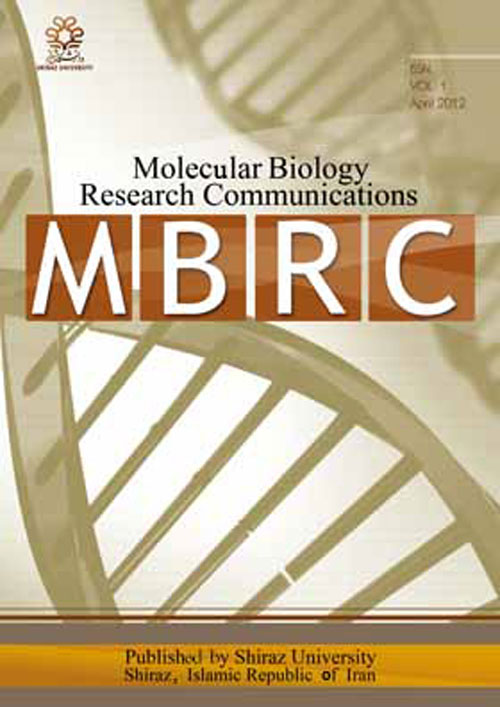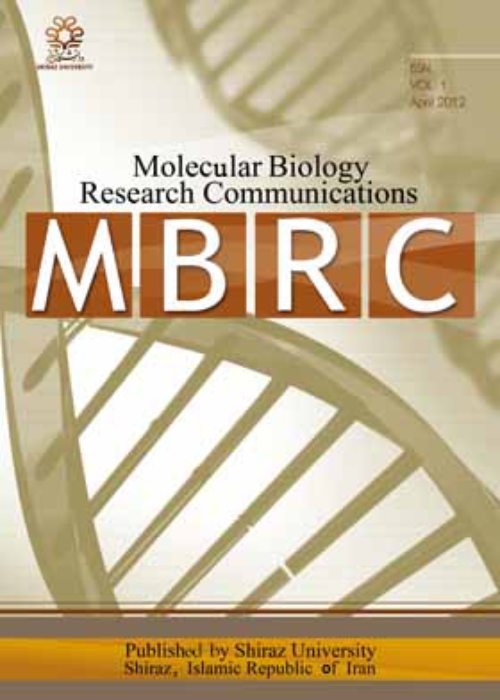فهرست مطالب

Molecular Biology Research Communications
Volume:4 Issue: 4, Dec 2015
- تاریخ انتشار: 1394/09/26
- تعداد عناوین: 6
-
-
Pages 167-179The interactions between platinum complexes and human serum albumin (HSA) play crucial roles in the distribution, metabolism, and activity of platinum-based anticancer drugs. Octahedral platinum (IV) complexes represent a significant class of anticancer agents that display molecular pharmacological properties different from cisplatin. In this study, the interaction between two Pt(IV) complexes with the general formula [Pt(X)2Me2 (tbu2bpy)], where tbu2bpy = 4,4′-ditert-butyl-2,2′-bipyridine, with two leaving groups of X = Cl (Com1) or Br (Com2), and HSA were investigated, using Ultraviolet-Visible (UV-Vis) spectroscopy, fluorescence spectroscopy, circular dichroism (CD) and molecular docking simulation. The spectroscopic and thermodynamic data revealed that the HSA/Pt(IV) complexes interactions were spontaneous process and Com2 demonstrated stronger interaction and binding constant in comparison with Com1. Also, the results suggest approximately similar structural alteration of HSA in the presence of these Pt complexes. Molecular docking revealed that both Pt(IV) complexes bind with HSA in subdomain IB, literally the same as each other. This study suggests that variation in the leaving group, displaying differing departure rate, has no significant contribution in denaturing prosperities of the Pt(IV) complexes against HSA.Keywords: Human serum albumin, Platinum (IV) complexes, Spectroscopic studies, Molecular docking simulation
-
Pages 181-188The mRNA expression of growth hormone (GH) gene in early development stages of Siberian sturgeon was investigated using RT-PCR method. Samples were collected from unfertilized eggs up to 50 days post hatched (dph) larvae in 11 different times. Ribosomal protein L6 (RPL6) transcripts were used as the internal standard during quantification of GH mRNA expression. The results showed that the GH mRNA could be observed in the eyed eggs and even at unfertilized eggs of Siberian sturgeon. The highest amounts of GH mRNA were found at 25 and 50 dph larvae, while the lowest levels were detected at 1 and 3 dph larvae stage. These findings suggest that, the GH mRNA play a key role during developmental stages of Siberian sturgeon.Keywords: Siberian sturgeon, Growth hormone, mRNA expression, RT, PCR
-
Pages 189-206The Iranian Persian chub is an endemic species of the family Cyprinidae known only from few localities in drainages of Southern Iran. It was originally described in the genus Pseudophoxinus as (Pseudophoxinus persidis) and then Petroleuciscus (as Petroleuciscus persidis). In this study, we examined phylogenetic relationships of the Iranian Persian chubwith other relatives in the family Cyprinidae based on the mitochondrial cytochrome b gene to estimate the phylogenetic (and taxonomic) position of the species. Our molecular phylogenies show that new fish sequences from the drainages in southern Iran are clustered with sequences of the genus Acanthobrama from GenBank while the sequences from two other genera (Pseudophoxinus and Petroleuciscus) are in distinct clade. Therefore, we conclude that the populations of Persian Chub in drainages of southern Iran (i.e., Kol, Kor, Maharlu and Persis) belong to the genus Acanthobrama andspecies Acanthobrama persidis. The predicted geographic distributions for the species showed a large area of suitable climate for A. persidis across south and west of Iran especially in the Kor River basin. Some other parts in the Persis and Tigris are also might have been suitable habitats for this cyprinid species showing possible dispersal route of Acanthobrama from Tigris to the Persis, Kor and Kol basins.Keywords: mt, DNA, Persian Chub, Pseudophoxinus, Petroleuciscus, Iranian drainages
-
Pages 207-216In India, more than 104 species of Myxobolus have so far been reported infecting freshwater as well as marine fishes. The study focuses on the description of a new myxosporean species, Myxobolus sp.n PKB 2014 from the gill lamellae of an Indian major carp Labeo rohita. The species have been described on the basis of morphological characterization of the spores, tissue architecture and 18S rDNA sequence data. The plasmodia of Myxobolus sp.n PKB 2014 were round in shape measuring, 50 to 70 μm in diameter and spores were ellipsoidal in frontal view measures 14.7 ± 0.51 μm. The 18S rRNA nucleotide sequence with 806 bp of Myxobolus sp.n PKB 2014 (Accession number KJ652226) clustered phylogenitically with other Myxobolus spp. infecting cyprinid gills with 90-99% similarity. According to the phylogenetic study we concluded that M. wulli was the closest relative having 99% similarity with the species under description but the sequence was distinct in each species which additionally exhibited different morphological features. The infection rate was low to moderate. After through comparison it can be concluded that the species being described here is new to science which is designated as Myxobolus sp.n.PKB 2014.Keywords: Myxobolus sp.n PKB2014, West Bengal, Labeo rohita, 18S rRNA, Phylogenetic relationship
-
Pages 217-224Hypermethylation of CpG islands located in the promoter regions of genes is a major event in the development of the majority of cancer types, due to the subsequent aberrant silencing of important tumor suppressor genes. KLOTHO; a novel gene associated primarily with suppressing senescence has been shown to contribute to tumorigenesis as a result of its impaired function. Recently the relevance of KLOTHO promoter hypermethylation in colorectal carcinoma in humans has been reported. We analyzed the promoter hypermethylation of KLOTHO gene in 50 histopathologically confirmed tumor and adjacent normal tissues of colorectal cancer patients. Methylation was assessed by bisulfite conversion of DNA followed by methylation specific-polymerase chain reaction. Methylation status was compared with gender, smoking status and histopathological parameters of patients. Promoter hypermethylation in KLOTHO gene was detected in 86% (43/50) of tumor tissues and 14% (7/50) of adjacent normal tissues. The methylation pattern differed significantly between tumor and adjacent normal tissues (P<0.0001). However, no association was found between promoter hypermethylation status and gender (P=0.68), smoking status (P=0.64) or other histopathological parameters (P>0.05) of colorectal cancer patients. We conclude that this novel tumor suppressor gene is epigenetically inactivated in colorectal cancer in our population paving way towards the potential of KLOTHO promoter hypermethylation as a predictor of the prognosis in colorectal cancer patients.Keywords: KLOTHO, Promoter hypermethylation, Colorectal cancer, Tumor suppressor
-
Pages 225-237The genetic variation and population structure of narrow-clawed crayfish (Astacus leptodactylus) was examined by means of polymerase chain reaction (PCR) restriction fragment length polymorphism (RFLP) analysis of the cytochrome oxidase subunit I (COI) of mitochondrial DNA. A total of 194 adult specimens were collected from seven sample sites including, two in the south Caspian Sea and one each in Anzali wetland and Aras reservoir and three rivers Chafrood, Masule Rudkhan and Siah Darvishan. The PCR products were digested with 19 restriction enzymes and five enzymes revealed polymorphism patterns (DdeІ, MboІ, TaqI, RsaІ and HinfІ). Twenty eight composite haplotypes were showed with the number of haplotypes in each population sample ranging from 8 to 13. Private haplotypes were found at very low frequencies. Two regional (Siah Darvishan River and Astara) groups were clearly recognized by cluster and molecular variance model (AMOVA) analyses (P<0.0001). Each of these groups revealed dominant haplotypes while these haplotypes play less important rule in population structures of the other geographic areas. Intrapopulation haplotype (h) and nucleotide (π) diversities were high for each locality, ranging h=0.7560±0.030 and π= 0.00334±0.00301, respectively. Results of this study discerned two genetically divergent populations of narrow-clawed crayfish including Siah Darvishan River and Astara. Thus, the population structure of the narrow-clawed crayfish, as inferred from mtDNA analysis, is constituted by genetically separate groups that nearly reflect their geographic distribution.Keywords: Astacus leptodactylus, Mitochondrial DNA, PCR, RFLP, Genetic diversity


